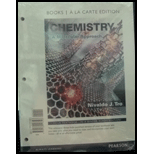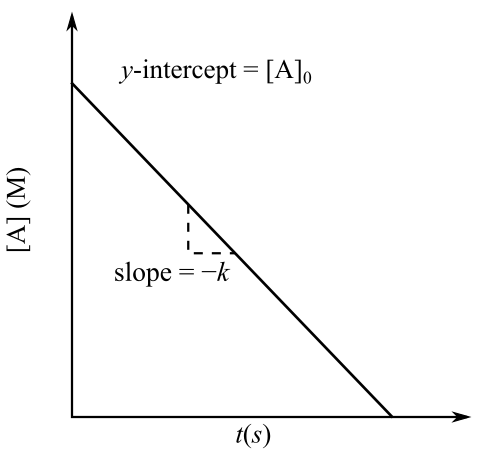
Chemistry: A Molecular Approach, Books a la Carte Plus Mastering Chemistry with Pearson eText -- Access Card Package (4th Edition)
4th Edition
ISBN: 9780134162454
Author: Nivaldo J. Tro
Publisher: PEARSON
expand_more
expand_more
format_list_bulleted
Question
Chapter 14, Problem 36E
(a)
Interpretation Introduction
To give: The order of the reaction with respect to A.
(b)
Interpretation Introduction
To draw: A rough sketch of a plot of
Graph:

(c)
Interpretation Introduction
To write: A rate law for the reaction, including the value of k.
Expert Solution & Answer
Want to see the full answer?
Check out a sample textbook solution
Students have asked these similar questions
3. Name this ether correctly.
H₁C
H3C
CH3
CH3
4. Show the best way to make the ether in #3 by a
Williamson Ether Synthesis.
Start from an alcohol or phenol.
5. Draw the structure of an example of a sulfide.
1. Which one(s) of these can be oxidized with CrO3 ?
(could be more than one)
a) triphenylmethanol
b) 2-pentanol
c) Ethyl alcohol
d)
CH3
2. Write in all the product(s) of this reaction. Label them
as "major" or "minor".
2-methyl-2-hexanol
H2SO4, heat
3) Determine if the pairs are constitutional isomers, enantiomers, diastereomers, or mesocompounds.
(4 points)
Chapter 14 Solutions
Chemistry: A Molecular Approach, Books a la Carte Plus Mastering Chemistry with Pearson eText -- Access Card Package (4th Edition)
Ch. 14 - Prob. 1SAQCh. 14 - Q2. Dinitrogen monoxide decomposes into nitrogen...Ch. 14 - Q3. This plot shows the rate of the decomposition...Ch. 14 - Q4. For the reaction 2 A + B → C, the initial rate...Ch. 14 - Prob. 5SAQCh. 14 - Prob. 6SAQCh. 14 - Prob. 7SAQCh. 14 - Prob. 8SAQCh. 14 - Q9. The rate constant of a reaction is measured at...Ch. 14 - Prob. 10SAQ
Ch. 14 - Prob. 11SAQCh. 14 - Q12. Which statement is true regarding the...Ch. 14 - Prob. 13SAQCh. 14 - Q14. Use collision theory to determine which...Ch. 14 - Q15. Carbon monoxide and chlorine gas react to...Ch. 14 - Prob. 1ECh. 14 - Prob. 2ECh. 14 - Prob. 3ECh. 14 - 4. Why is the reaction rate for reactants defined...Ch. 14 - Prob. 5ECh. 14 - Prob. 6ECh. 14 - Prob. 7ECh. 14 - 8. For a reaction with multiple reactants, how is...Ch. 14 - 9. Explain the difference between the rate law for...Ch. 14 - 10. Write integrated rate laws for zero-order,...Ch. 14 - Prob. 11ECh. 14 - 12. How do reaction rates typically depend on...Ch. 14 - Prob. 13ECh. 14 - 14. What is an Arrhenius plot? Explain the...Ch. 14 - Prob. 15ECh. 14 - Prob. 16ECh. 14 - 17. In a reaction mechanism, what is an elementary...Ch. 14 - 18. What are the two requirements for a proposed...Ch. 14 - 19. What is an intermediate within a reaction...Ch. 14 - Prob. 20ECh. 14 - 21. Explain the difference between homogeneous...Ch. 14 - Prob. 22ECh. 14 - Prob. 23ECh. 14 - Prob. 24ECh. 14 - 25. Consider the reaction:
2 HBr(g) → H2(g) +...Ch. 14 - 26. Consider the reaction:
2 N2O(g) → 2 N2(g) +...Ch. 14 - 27. For the reaction 2 A(g) + B(g) → 3 C(g),
a....Ch. 14 - 28. For the reaction A(g) + B(g) → 2 C(g),
a....Ch. 14 - 29. Consider the reaction:
Cl2(g) + 3 F2(g) → 2...Ch. 14 - Prob. 30ECh. 14 - Prob. 31ECh. 14 - Prob. 32ECh. 14 - Prob. 33ECh. 14 - 34. Consider the reaction:
2 H2O2(aq) → 2 H2O(l) +...Ch. 14 - Prob. 35ECh. 14 - Prob. 36ECh. 14 - Prob. 37ECh. 14 - 38. This reaction is first order in N2O5:
N2O5(g)...Ch. 14 - Prob. 39ECh. 14 - Prob. 40ECh. 14 - Prob. 41ECh. 14 - 42. Consider the data showing the initial rate of...Ch. 14 - Prob. 43ECh. 14 - Prob. 44ECh. 14 - 45. The tabulated data were collected for this...Ch. 14 - 46. The tabulated data were collected for this...Ch. 14 - 47. Indicate the order of reaction consistent with...Ch. 14 - 48. Indicate the order of reaction consistent with...Ch. 14 - 49. The tabulated data show the concentration of...Ch. 14 - Prob. 50ECh. 14 - 51. The tabulated data show the concentration of...Ch. 14 - 52. The reaction A → products was monitored as a...Ch. 14 - Prob. 53ECh. 14 - Prob. 54ECh. 14 - Prob. 55ECh. 14 - Prob. 56ECh. 14 - 57. The half-life for the radioactive decay of...Ch. 14 - 58. The half-life for the radioactive decay of...Ch. 14 - Prob. 59ECh. 14 - Prob. 60ECh. 14 - Prob. 61ECh. 14 - Prob. 62ECh. 14 - Prob. 63ECh. 14 - Prob. 64ECh. 14 - 65. The data shown here were collected for the...Ch. 14 - Prob. 66ECh. 14 - 67. The tabulated data were collected for the...Ch. 14 - 68. The tabulated data show the rate constant of a...Ch. 14 - 69. A reaction has a rate constant of 0.0117/s at...Ch. 14 - 70. A reaction has a rate constant of 0.000122/s...Ch. 14 - Prob. 71ECh. 14 - Prob. 72ECh. 14 - Prob. 73ECh. 14 - Prob. 74ECh. 14 - Prob. 75ECh. 14 - Prob. 76ECh. 14 - Prob. 77ECh. 14 - Prob. 78ECh. 14 - 79. Many heterogeneous catalysts are deposited on...Ch. 14 - 80. Suppose that the reaction A → products is...Ch. 14 - 81. Suppose that a catalyst lowers the activation...Ch. 14 - Prob. 82ECh. 14 - Prob. 83ECh. 14 - Prob. 84ECh. 14 - Prob. 85ECh. 14 - Prob. 86ECh. 14 - Prob. 87ECh. 14 - Prob. 88ECh. 14 - Prob. 89ECh. 14 - Prob. 90ECh. 14 - 91. Iodine atoms combine to form I2 in liquid...Ch. 14 - 92. The hydrolysis of sucrose (C12H22O11) into...Ch. 14 - Prob. 93ECh. 14 - Prob. 94ECh. 14 - Prob. 95ECh. 14 - Prob. 96ECh. 14 - 97. The desorption (leaving of the surface) of a...Ch. 14 - Prob. 98ECh. 14 - 99. The kinetics of this reaction were studied as...Ch. 14 - Prob. 100ECh. 14 - Prob. 101ECh. 14 - 102. Consider the two reactions:
a. Why is the...Ch. 14 - 103. Anthropologists can estimate the age of a...Ch. 14 - 104. Geologists can estimate the age of rocks by...Ch. 14 - Prob. 105ECh. 14 - 106. Consider the reaction:
2 NH3(aq) + OCl–(aq) →...Ch. 14 - Prob. 107ECh. 14 - Prob. 108ECh. 14 - Prob. 109ECh. 14 - Prob. 110ECh. 14 - Prob. 111ECh. 14 - Prob. 112ECh. 14 - 113. In this chapter we have seen a number of...Ch. 14 - Prob. 114ECh. 14 - 115. The previous exercise shows how the...Ch. 14 - Prob. 116ECh. 14 - Prob. 117ECh. 14 - Prob. 118ECh. 14 - Prob. 119ECh. 14 - Prob. 120ECh. 14 - Prob. 121ECh. 14 - Prob. 122ECh. 14 - Prob. 123QGWCh. 14 - 124. A certain compound, A, reacts to form...Ch. 14 - 125. The color of food is an important component...
Knowledge Booster
Learn more about
Need a deep-dive on the concept behind this application? Look no further. Learn more about this topic, chemistry and related others by exploring similar questions and additional content below.Similar questions
- In the decomposition reaction in solution B → C, only species C absorbs UV radiation, but neither B nor the solvent absorbs. If we call At the absorbance measured at any time, A0 the absorbance at the beginning of the reaction, and A∞ the absorbance at the end of the reaction, which of the expressions is valid? We assume that Beer's law is fulfilled.arrow_forward> You are trying to decide if there is a single reagent you can add that will make the following synthesis possible without any other major side products: 1. ☑ CI 2. H3O+ O Draw the missing reagent X you think will make this synthesis work in the drawing area below. If there is no reagent that will make your desired product in good yield or without complications, just check the box under the drawing area and leave it blank. Click and drag to start drawing a structure. Explanation Check ? DO 18 Ar B © 2025 McGraw Hill LLC. All Rights Reserved. Terms of Use | Privacy Center | Accessibilityarrow_forwardDon't use ai to answer I will report you answerarrow_forward
- Consider a solution of 0.00304 moles of 4-nitrobenzoic acid (pKa = 3.442) dissolved in 25 mL water and titrated with 0.0991 M NaOH. Calculate the pH at the equivalence pointarrow_forwardWhat is the name of the following compound? SiMe3arrow_forwardK Draw the starting structure that would lead to the major product shown under the provided conditions. Drawing 1. NaNH2 2. PhCH2Br 4 57°F Sunny Q Searcharrow_forward
- 7 Draw the starting alkyl bromide that would produce this alkyne under these conditions. F Drawing 1. NaNH2, A 2. H3O+ £ 4 Temps to rise Tomorrow Q Search H2arrow_forward7 Comment on the general features of the predicted (extremely simplified) ¹H- NMR spectrum of lycopene that is provided below. 00 6 57 PPM 3 2 1 0arrow_forwardIndicate the compound formula: dimethyl iodide (propyl) sulfonium.arrow_forward
arrow_back_ios
SEE MORE QUESTIONS
arrow_forward_ios
Recommended textbooks for you
 ChemistryChemistryISBN:9781305957404Author:Steven S. Zumdahl, Susan A. Zumdahl, Donald J. DeCostePublisher:Cengage Learning
ChemistryChemistryISBN:9781305957404Author:Steven S. Zumdahl, Susan A. Zumdahl, Donald J. DeCostePublisher:Cengage Learning ChemistryChemistryISBN:9781259911156Author:Raymond Chang Dr., Jason Overby ProfessorPublisher:McGraw-Hill Education
ChemistryChemistryISBN:9781259911156Author:Raymond Chang Dr., Jason Overby ProfessorPublisher:McGraw-Hill Education Principles of Instrumental AnalysisChemistryISBN:9781305577213Author:Douglas A. Skoog, F. James Holler, Stanley R. CrouchPublisher:Cengage Learning
Principles of Instrumental AnalysisChemistryISBN:9781305577213Author:Douglas A. Skoog, F. James Holler, Stanley R. CrouchPublisher:Cengage Learning Organic ChemistryChemistryISBN:9780078021558Author:Janice Gorzynski Smith Dr.Publisher:McGraw-Hill Education
Organic ChemistryChemistryISBN:9780078021558Author:Janice Gorzynski Smith Dr.Publisher:McGraw-Hill Education Chemistry: Principles and ReactionsChemistryISBN:9781305079373Author:William L. Masterton, Cecile N. HurleyPublisher:Cengage Learning
Chemistry: Principles and ReactionsChemistryISBN:9781305079373Author:William L. Masterton, Cecile N. HurleyPublisher:Cengage Learning Elementary Principles of Chemical Processes, Bind...ChemistryISBN:9781118431221Author:Richard M. Felder, Ronald W. Rousseau, Lisa G. BullardPublisher:WILEY
Elementary Principles of Chemical Processes, Bind...ChemistryISBN:9781118431221Author:Richard M. Felder, Ronald W. Rousseau, Lisa G. BullardPublisher:WILEY

Chemistry
Chemistry
ISBN:9781305957404
Author:Steven S. Zumdahl, Susan A. Zumdahl, Donald J. DeCoste
Publisher:Cengage Learning

Chemistry
Chemistry
ISBN:9781259911156
Author:Raymond Chang Dr., Jason Overby Professor
Publisher:McGraw-Hill Education

Principles of Instrumental Analysis
Chemistry
ISBN:9781305577213
Author:Douglas A. Skoog, F. James Holler, Stanley R. Crouch
Publisher:Cengage Learning

Organic Chemistry
Chemistry
ISBN:9780078021558
Author:Janice Gorzynski Smith Dr.
Publisher:McGraw-Hill Education

Chemistry: Principles and Reactions
Chemistry
ISBN:9781305079373
Author:William L. Masterton, Cecile N. Hurley
Publisher:Cengage Learning

Elementary Principles of Chemical Processes, Bind...
Chemistry
ISBN:9781118431221
Author:Richard M. Felder, Ronald W. Rousseau, Lisa G. Bullard
Publisher:WILEY
Kinetics: Chemistry's Demolition Derby - Crash Course Chemistry #32; Author: Crash Course;https://www.youtube.com/watch?v=7qOFtL3VEBc;License: Standard YouTube License, CC-BY